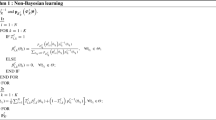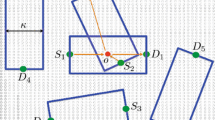Abstract
In this paper, we propose a dynamic rate allocation and relaying strategy adaption scheme for data transmission over wireless relay networks, where autonomous nodes expose node-selfishness, i.e. being unwilling to forward other nodes’ data packets, for saving their energy resources. Aided by an incentive mechanism, we develop a virtual node-selfishness queue (VSQ) to portray the node’s dynamic selfish characteristic in terms of its energy resource and incentives. Then, a stochastic optimization model is employed to maximize the average network throughput whilst keeping the network stable and bounding the node-selfishness. The problem of stochastic optimization is further decomposed into two subproblems via the Lyapunov optimization theory, which corresponds to the rate allocation for source and the relaying strategy adaption for autonomous relay, respectively. After that, a joint rate allocation and relaying strategy adaption algorithm is developed to accommodate the wireless network only according to the current network state information, i.e. the data queue sate information, VSQ information at relays and the channel state information of the links. The explicit tradeoff between network throughput and average data transmission delay is theoretically proven. Simulation results validate the theoretical analysis of our proposed scheme.





Similar content being viewed by others
Notes
A network is called stable if all individual queues of the network are stable.
The value of node-selfishness keeps less than the infinity, which means that the node being completely selfish is avoided.
The probability that the relay forwards the received data.
The incentive mechanisms have two categories, the price-based and reputation-based schemes. The price-based scheme provides incentives by the way of virtual currency paid to nodes for offering services. The reputation-based mechanism uses the nodes’ historical behaviors to assess their reputations, and then distinguishes the selfish nodes by setting a reputation threshold.
A session-based service comes from the transport or/and upper layers.
The capacity region \(\varLambda\) is defined as all of the data arrival rate \(\varvec{\lambda }\) that can be stably supported by the wireless network, considering all possible rate and forwarding strategy control decisions.
References
Li, P., & Guo, S. (2013). On the multicast capacity in energy-constrained lossy wireless networks by exploiting intrabatch and interbatch network coding. IEEE Transactions on Parallel and Distributed Systems, 24(11), 2251–2260.
Cao, B., Li, Y., Wang, C., & Feng, G. (2015). Dynamic cooperative media access control for wireless networks. Wireless Communications and Mobile Computing Conference, 15(13), 1759–1772.
Cao, B., Chen, Q., Feng, G., Li, Y., & Wang, C. (2017). Revisiting relay assignment in cooperative communications. Wireless Networks, 32(2), 609–623.
Orallo, E., Olmos, M., Cano, J., & Calafate, C. (2015). CoCoWa: A collaborative contact-based watchdog for detecting selfish nodes. IEEE Transactions on Mobile Computing, 14(6), 1162–1175.
Kong, Z., Kwok, Y., & Wang, J. (2008). On the impact of selfish behaviors in wireless packet scheduling. In Proceedings of IEEE ICC (pp. 3253–3257).
Li, Z., & Shen, H. (2012). Game-theoretic analysis of cooperation incentive strategies in mobile ad hoc networks. IEEE Transactions on Mobile Computing, 11(8), 1287–1303.
Bertsekas, D., & Gallager, R. (1987). Data networks. Prentice-Hall.
Neely, M. (2010). Stochastic network optimization with application to communication and queueing systems. Morgan & Claypool.
Luo, C., Guo, S., & Yang, T. (2014). Green communication in energy renewable wireless mesh networks: routing, rate control, and power allocation. IEEE Transactions on Parallel and Distributed Systems, 25(12), 3211–3220.
Cao, B., Feng, G., Li, Y., & Wang, C. (2014). Cooperative media access control with optimal relay selection in error-prone wireless networks. IEEE Transactions on Vehicular Technology, 63(1), 252–265.
Jiang, C., Chen, Y., & Liu, K. (2013). Distributed adaptive networks: a graphical evolutionary game-theoretic view. IEEE Transactions on Signal Processing, 61(22), 5675–5688.
Zhu, H., Pandana, C., & Liu, K. (2005). A self-learning repeated game framework for optimizing packet forwarding networks. InProceedings of IEEE WCNC (pp. 2131–2136).
Clark, A., Pande, A., Govindan, K., & Poovendran, R. (2013). Using social information for flow allocation in MANETs. Computer Science
Bao, F., Chen, I., Chang, M., & Cho, J. (2012). Hierarchical trust management for wireless sensor networks and its applications to trust-based routing and intrusion detection. IEEE Transactions on Network and Service Management, 9(2), 169–183.
Mastronarde, N., Patel, V., Xu, J., & Liu, L. (2015). To relay or not to relay: Learning device-to-device relaying strategies in cellular networks. IEEE Transactions on Mobile Computing, 15(6), 1569–1585.
Neely, M. (2012). Dynamic optimizaton and learning for renewal systems view document. IEEE Transactions on Automatic Control, 58(1), 32–46.
Ma, X., Sheng, M., & Zhang, Y. (2012). Green communications with network cooperation: A concurrent transmission approach. IEEE Communications Letters, 16(12), 1952–1955.
Fang, W., Li, Y., Zhang, H., & Xiong, N. (2014). On the throughput-energy tradeoff for data transmission between cloud and mobile devices. Information Sciences, 283, 79–93.
Li, Y., Shi, Y., Sheng, M., & Wang, C. (2015). Energy-efficient transmission in heterogeneous wireless networks: A delay-aware approach. IEEE Transactions on Vehicular Technology, 65(9), 7488–7500.
Zhu, H., Lu, X., & Fan, Y. (2009). SMART: A secure multilayer credit-based incentive scheme for delay-tolerant networks. IEEE Transactions on Vehicular Technology, 58(8), 4628–4639.
Xu, Q., Su, Z., & Guo, S. (2016). A game theoretical incentive scheme for relay selection services in mobile social networks. IEEE Transactions on Vehicle Technology, 65(8), 6692–6702.
Xu, W., Zhang, Y., Shi, Q., & Wang, X. (2015). Energy management and cross layer optimization for wireless sensor network powered by heterogeneous energy sources. IEEE Transactions on Wireless Communications, 14(5), 2814–2826.
Meester, R., & Trapman, P. (2010). Bounding basic characteristics of spatial epidemics with a new percolation model. arxiv.org/abs/0812.4353.
Georgiadis, L., Neely, M., & Tassiulas, L. (2006). Resource allocation and cross-layer control in wireless networks. Foundations and Trends in Networking, 1(1), 1–144.
Vu, Q., Tran, L., & Farrell, R. (2015). An efficiency maximization design for SWIPT. IEEE Signal Processing Letters, 22(12), 2189–2193.
Palomar, D., & Chiang, M. (2006). A tutorial on decomposition methods for network utility maximization. IEEE Journal on Selected Areas in Communications, 24(8), 1439–1451.
Uchimura, Y., Nasu, T., & Takahashi, M. (2010). IEEE 802.11-based wireless sensor system for vibration measurement. Advances in Civil Engineering. doi:10.1155/2010/631939.
Author information
Authors and Affiliations
Corresponding author
Appendices
Appendices
1.1 Appendix 1: Proof of Lemma 1
Followed from Eq. (8), we have
where we have used the queue evolution in Eqs. (1) and (3).
Based on the inequality property that \((\max [Q-r,0]+f)^{2}\le Q^{2}+r^{2}+f^{2}+2Q(f-r)\), we obtain
where B is an upper bound on the term \(\frac{1}{2}[(1+(\mathcal {R}^g)^2)(\mathbf {R}^{t})^{H}(\mathbf {R}^{t})+(\mathbf {F}_m^{t})^{H}(\mathbf {F}_m^{t})+(\mathcal {R}^p\mathbf {R}^{t})^{2}+\mathbf {S}^{2}(P^T)^2+(P^R\mathbf {F}_m^{t})^2]\), which holds under the fact that the data rates satisfy the properties of boundness. Adding \(-V{\bar{\mathbf{E}}}[U^{t}({\alpha }^{t}, \mathbf {h}^{t})|{\varvec{\Theta }}^{t}]\) to both sides of Eq. (15) and taking a expectation, yields
This completes the proof of Lemma 1.
1.2 Appendix 2: Proof of Lemma 2
Since there at least exists a rate allocation policy that stabilizes the wireless network under arriving data session rate \(\varvec{\lambda }+\varepsilon\). Then, we obtain that \(\varvec{\lambda }\) is strictly interior to the capacity region \(\varLambda\), and that \(\varvec{\lambda }+\varepsilon\) is still in \(\varLambda\) for a positive \(\varepsilon\), there exist a \(\mathbf {h}\)-only policy that
where \(\tilde{r}_{s,n}^{f_{m},t}\), \(\tilde{r}_{n,m}^{f_{m},t}\), \(\tilde{s}_{n,m}^{t}\) and \(\tilde{r}_{s,n}^{f_{n},t}\) are the resulting values at time-slot t under \(\mathbf {h}\)-only policy.
Due to the rate allocation in Eq. (12), then
Similarly,
The rate set \({\mathbf {F}}^{t}\) and relaying strategy \({\mathbf {S}}^{t}\) obtained by Algorithm 1 have better performance than the \(\mathbf {h}\)-only policy. There comes the equation at the top of the former page.
1.3 Appendix 3: Proof of Theorem 1
(a) Note that \(Q_{n,m}^t\ge 0\) and \(T_{n,m}^t\ge 0\) in this paper. Then, combining Eq. (10) in Lemma 1 and the conclusions in Lemma 2, we have
where \(\overline{U}^{opt}\) is the average optimal utility of \(\mathbf {h}\)-only policy. From Proposition 1, we have \(\varDelta ({\varvec{\Theta }})^{t}\le \psi\) where \(\psi\) is a constant. Taking telescoping sum over \(t\in \{0,1,\ldots ,\varsigma -1\}\) in the above inequality and using Eq. (10), we get
From the variance formula: \(D(\mid T_n(\varsigma )\mid )=\mathbb {E}(\mid T_n(\varsigma )\mid ^2)-[\mathbb {E}(\mid T_n(\varsigma )\mid )]^2\), we have \(\mathbb {E}(\mid T_n(\varsigma )\mid ^2)\ge [\mathbb {E}(\mid T_n(\varsigma )\mid )]^2\). Thus
Dividing by \(\varsigma\) and taking a limit as \(\varsigma \rightarrow \infty\) prove \(\lim _{\varsigma \rightarrow \infty }\frac{\mathbb {E}\{\mid T_n(\varsigma )\mid \}}{\varsigma }=0\).
Hence, queues \(T_{n,m}^t\) are mean rate stable from Definition 1. Similarly, we can prove that queues \(Q_{n,m}^t\) are mean rate stable as well.
(b) After having summed over \(t\in \{0,1,\cdots ,\varsigma -1\}\) for Eq. (17), we get
Then, following from the general derivation in [8], we get
Taking limit as \(\varsigma \rightarrow \infty\), we comes the solution that \(\overline{U} \ge \overline{U}^{opt}- B/V\).
(c). Summing Eq. (17) over \(t\in \{0,1,\cdots ,\varsigma -1\}\), we get
Similarly, employing the derivation method, we get
Taking the limit as \(\varsigma \rightarrow \infty\) and dividing by \(\varepsilon\), we have
based on the Proposition 1. Thus, the theorem for time averaged queues is proved.
Rights and permissions
About this article
Cite this article
Feng, L., Yang, Q., Wu, W. et al. Rate allocation and relaying strategy adaption in wireless relay networks. Wireless Netw 24, 2669–2683 (2018). https://doi.org/10.1007/s11276-017-1498-x
Published:
Issue Date:
DOI: https://doi.org/10.1007/s11276-017-1498-x




